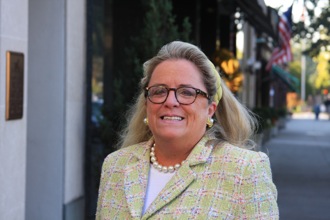From the Mayor: Mother's Day and Memorial Day

By Mary C. Marvin, Mayor, Village of Bronxville
May 9, 2018: May brings two holidays very much celebrated in our village--Mother’s Day and Memorial Day--so I decided to do a little research as to the origins and meanings.
Celebrations of mothers and motherhood can be traced back to the ancient Greeks and Romans, who held festivals in honor of the mother goddesses Rhea and Cybele, but the clearest modern precedent for Mother’s Day is the early Christian festival known as “Mothering Sunday.”
Once a major tradition in the United Kingdom and parts of Europe, this celebration fell on the fourth Sunday in Lent and was originally seen as a time when the faithful would return to their “mother church”--the main church in the vicinity of their home--for a special service.
The American incarnation of Mother’s Day was created by Anna Reeves Jarvis in West Virginia in the mid-1800s in the form of “Mother’s Day Work Clubs” to teach local women proper childcare. They grew into a unifying force in a region of the country still divided over the Civil War. In 1868, Jarvis organized “Mother’s Friendship Day,” at which mothers gathered with former Union and Confederate soldiers to promote reconciliation.
Another precursor to Mother’s Day as we know it came from the abolitionist and suffragette Julia Ward Howe. In 1870, Howe wrote the “Mother’s Day Proclamation,” a call to action that asked mothers to unite in promoting world peace.
The “official” Mother’s Day holiday arose in the 1900s as a result of the efforts of Anna Jarvis, daughter of Ann Reeves Jarvis, to honor her recently deceased mother.
With the financial backing of John Wanamaker of the eponymous department store in Philadelphia, she held the first official celebrations in West Virginia and Philadelphia.
Arguing that American holidays were biased toward male achievements, she was relentless in a letter-writing campaign and political advocacy to adopt a special day for mothers. Her persistence paid off in 1914 when President Woodrow Wilson signed an official proclamation establishing the second Sunday in May as Mother’s Day.
Anna Jarvis, who remained unmarried and childless her whole life, conceived of the day as spent attending church and visiting one’s mother. She came to deplore the commercialization of the holiday and spent most of her personal wealth and her later years lobbying the government to have it removed from the American calendar.
A point of trivia--more phone calls are made on Mothers’ Day than any other day of the year, spiking phone traffic by as much as 38%.
Memorial Day, first known as Decoration Day, originated in the years immediately following the Civil War and became an official holiday only in 1971.
Ending in 1865, the Civil War claimed more American lives than any conflict in the country's history and required the establishment of the country’s first national cemeteries.
By the late 1860s, Americans had begun holding springtime tributes to these countless fallen soldiers, decorating their graves with flowers and reciting prayers.
In 1868, General John Logan, leader of an organization for Northern Civil War veterans, called for a nationwide day of remembrance on the 30th of May, choosing that date because it was not the anniversary of any battle. By 1890, every Northern state, but no Southern state, made “Decoration Day” an official state holiday.
With such prophetic words, General Logan stated, “Let no neglect, no ravages of time, testify to the present or to the coming generations, that we have forgotten as a people the cost of a free and undivided republic.”
Currently, eleven states still set a different official day to honor those who lost their lives fighting for the Confederacy. Virginia is the only state that observes Confederate Memorial Day on the same day as Memorial Day.
During World War I, the holiday evolved to commemorate American military personnel who died in all wars. Always celebrated on May 30, Congress made it a federal holiday in 1971 and established Memorial Day as the last Monday in May in order to create a three day holiday for federal workers.
The first Memorial Day ceremony was held at Arlington National Cemetery, where the tradition of placing small American flags beside each grave was first begun.
Cities across America began to host parades, with the largest always taking place in Chicago, New York, and Washington, D.C., where upwards of 250,000 citizens attend annually.
In 2000, President Clinton signed a National Moment of Remembrance Act asking Americans to pause and observe a moment of remembrance at 3:00 pm on Memorial Day. Amtrak trains blast all of their whistles at that moment and Major League Baseball and NASCAR pause events. Flags should also be flown at half-staff until noon on the holiday.
The origins of special services to honor those who die in war can be found in antiquity. The Athenian leader Pericles offered a tribute to the fallen heroes of the Peloponnesian War over 24 centuries ago that could be applied today to the 1.1 million Americans who have died in the nation’s wars: “Not only are they commemorated by columns and inscriptions in their own country, but in foreign lands there dwells also an unwritten memorial of them, graven not on stone but in the hearts of men.”
Editor's note: As a public service, MyhometownBronxville publishes press releases, statements, and articles from local institutions, officeholders, candidates, and individuals. MyhometownBronxville does not fact-check statements therein, and any opinions expressed therein do not necessarily reflect the thinking of its staff.
Government & History Directory
Bronxville is a quaint village (one square mile) located just 16 miles north of midtown Manhattan (roughly 30 minutes on the train) and has a population of approximately 6,500. It is known as a premier community with an excellent public school (K-12) and easy access to Manhattan. Bronxville offers many amenities including an attractive business district, a hospital (Lawrence Hospital), public paddle and tennis courts, fine dining at local restaurants, two private country clubs and a community library.
While the earliest settlers of Bronxville date back to the first half of the 18th century, the history of the modern suburb of Bronxville began in 1890 when William Van Duzer Lawrence purchased a farm and commissioned the architect, William A. Bates, to design a planned community of houses for well-known artists and professionals that became a thriving art colony. This community, now called Lawrence Park, is listed on the National register of Historic Places and many of the homes still have artists’ studios. A neighborhood association within Lawrence Park called “The Hilltop Association” keeps this heritage alive with art shows and other events for neighbors.
Bronxville offers many charming neighborhoods as well as a variety of living options for residents including single family homes, town houses, cooperatives and condominiums. One of the chief benefits of living in “the village” is that your children can attend the Bronxville School.
The Bronxville postal zone (10708, known as “Bronxville PO”) includes the village of Bronxville as well as the Chester Heights section of Eastchester, parts of Tuckahoe and the Lawrence Park West, Cedar Knolls, Armour Villa and Longvale sections of Yonkers. Many of these areas have their own distinct character. For instance, the Armour Villa section has many historic homes and even has its own newsletter called “The Villa Voice” which reports on neighborhood news.
Link to Village of Bronxville One Square Mile Monthly Newsletter
Village of Bronxville Administrative Offices
337-6500
Open 9:00am - 4pm excluding holidays and weekends
Bronxville Police Department
337-0500
Open 24 hours
Bronxville Parking Violations
337-2024
Open 9:00am - 4pm excluding holidays and weekends
Bronxville Fire Deparment
793-6400













